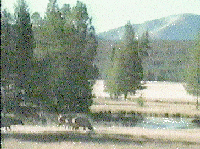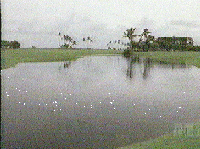
Nature's Earth
(This page is in 2 parts to make loading faster.)

Did you know:
The earth is 92.9 million miles from the sun and that the moon is a natural satellite.
Did you know: The earth has 5 main motions?
- it rotates daily on its axis;
- it revolves annually around the sun;
- it precesses, or wobbles, somewhat like a spinning top;
- it follows the sun in the sun's travel through the Milky Way, and
- it moves with the Milky Way as the entire galaxy travels through the universe.
Did you know:
The earth's magnetic field reverses periodically?
- The reasons are unknown, but geological evidence indicates the strength of the field gradually grows weaker, reaches a minimum or disappears entirely, and builds again in the opposite direction, resulting
in a reversal of the north and south magnetic poles. Science estimates such reversals occure about once every one-half to one million years. The last such reversal was 700,000 years ago.

Nature's Greatest
- Longest River =
4,100 mi; Nile River
- Largest Freshwater Lake =
31,800 sq mi; Lake Superior
- Largest Island =
840,000 sq mi; Greenland
- Highest Waterfall =
3,212 ft; Angel Falls, Venezuela
- Deepest Land Depression =
1,312 ft below sea level; Dead Sea Shore
- Highest Point =
29,028 ft; Mount Everest
- Greatest Ocean Depth =
35,810 ft below sea level; Mariana Trench, Pacific Ocean
- Lowest Recorded Temperature =
-128.6 F; Antartica, 1983
- Highest Recorded Temperature =
136.4 F; Azizia, Libya, 1922
- World's Largest Desert =
3,500,000sq mi; Sahara

Nature's World
Desert
Africa
El Djouf.....................................................Libyan..............................................Namib
Nubian......................................................Sahara..............................................Tenere
Asia
Dashi-i-Lut................................................Gobi.................................................Kara
Kum
Kyzyl Kum................................................Rub
al Khali......................................Syrian
Takla.........................................................Thar
Austrailia
Great Sandy..............................................Great
Victoria
North America
Great Salt Lake.........................................Mohave.............................................Sonoran
South America
Atacama..................................................Patagonia

Did you know: Deserts occupy between 15 and 20% of the earth's land surface. There are almost no clouds over a desert, causing the sun to bake the sand and prevent life.
Daytime summer temperatures range from 100 to 120 F while nighttime temperatures range near 70 F in the summer and below freezing in winter.

Forest
A forest is a dense growth of trees in a large area living with other plants such as shrubs, herbaceous plants, mosses, lichens, fungi, bacteria, insects, birds, mammals, and other animals. Some have been made into National Parks, such as Sequoia in California. There are 5 types of forest:
- Coniferous - mainly made up of cone-bearing trees, also called softwoods; trees include
cedars, firs, hemlocks, pines, spruces, and tamaracks; thrive mostly in North America, Europe, and Asia; in Canada, they're called boreal and in Eurasia, they're called taiga.
- Deciduous - mainly made up of hardwood trees, that in all but a few instances shed
their foilage at the end of each growing season; broad leaved trees include ashes, birches, beeches, elms, hickories, maples, oaks, and poplars.
- Mixed - a combination of both hardwood and softwood trees.
- Tropical Rain -
commonly called jungles, these forest consist mainly of tropical hardwood and softwood trees; largest rain forest in the world are located in the Amazon basin of South America; Africa's Congo basin; and Southeast Asia, including Indonesia.
- Other -usually small, these are called scrub or thorn forests.

Did you know:
Forest cover about 30% of the earth.

Lake (natural)
name/location................................................area(sq
mi).......depth(ft)......elevation(ft)
- Caspian Sea, USSR-Iran.................................143,200............3,363...........-91
- Superior, USA-Canada.....................................31,700............1,332...........600
- Victoria, Uganda-Kenya-Tanzaniz.....................26,800...............269........3,720
- Aral, USSR.......................................................24,900..............220...........170
- Huron, USA-Canada.........................................23,000..............750...........580
- Michigan, USA..................................................22,300..............922...........580
- Tanganyika, Burundi-Tanzania-Zambia-Zaire......12,700...........4,823........2,530
- Baykal, USSR...................................................12,200...........5,315........1,490
- Great Bear, Canada...........................................12,000...........1,463...........390
- Nyasa, Tanzania-Mozambique-Malawi..............11,200............2,280........1,550
- Great Slave, Canada..........................................11,000............2,015..........500
- Erie, USA-Canada..............................................9,900...............210...........570
- Winnipeg, Canada...............................................9,400.................60...........710
- Onterio, USA-Canada.........................................7,300...............244...........250

Did you know:
Some large bodies of water that are really lakes are commonly called seas such as the Dead, Aral, Caspian, and Salton. The Dead Sea is really a lake and is 1,312 feet below sea level while Lake Tricaca lies about 12,510 feet above sea level.

Continue to Earth Statistics page 2
Return
to Home page
This page hosted by Get
your ownFree Home Page
Get
your ownFree Home Page











![]() Get
your ownFree Home Page
Get
your ownFree Home Page